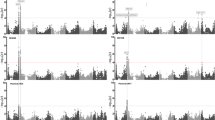Summary
Reciprocal sets of homozygous inbred backcross lines were developed by crossing two pure line varieties (Baart 46 and Ramona) of Triticum aestivum L., followed by two backcrosses to each of the two parent varieties, and six to eight generations of selfing. Data on each inbred backcross line was obtained from twelve plots (from replications in three years). Five genes were responsible for over 95% of the genetic variation for heading date. These genes had pleiotropic effects on plant height that were proportional to their effects on heading date. Two additional genes had detectable effects on plant height. The genes with a measurable effect on height accounted for 90% of the genetic variation in the Baart 46 genetic background. One gene affected seed weight. In the Ramona background, this gene accounted for 80% of the genetic variation in seed weight and 16% of the genetic variation in seed yield. Two genes, responsible for the earliest and latest heading date classes, had large pleiotropic effects on seed yield. They accounted for 60% of the genetic variation in yield. One gene, with no effect on heading date, caused a detectable reduction in yield of 23% in the Baart 46 inbred backcross lines. This gene had no apparent effect in the Ramona genetic background. Quantitative trait genes are sparsely distributed in the genome: fewer than one in four chromosome arms carries a gene with a detectable effect. Gene effects on quantitative traits are not small and similar. The distribution of 22 gene effects for heading date and height is slightly skewed to the right: as the magnitude of effect increases, the frequency of genes having the effect decreases.
Similar content being viewed by others
References
Allard RW (1956) Biometrical approach to plant breeding. In: Genetics in plant breeding. Brookhaven Symp Biol 9:69–88
Allard RW, Harding J (1963) Early generation analysis and prediction of gain under selection in derivatives of a wheat hybrid. Crop Sci 3:454–456
Allendorf FW, Knudsen KL, Leary RF (1983) Adaptive significance of differences in the tissue-specific expression of a phosphoglucomutase gene in rainbow trout. Proc Natl Acad Sci USA 80:1397–1400
Cochran WG, Cox GM (1957) Experimental designs, 2nd edn. Wiley, New York
Falconer DS (1981) Introduction to quantitative genetics, 2nd edn. Longman, London
Hallauer AR, Miranda JB (1981) Quantitative genetics in maize breeding. Iowa State Press, Ames/IA
Kahler AL, Wehrhahn CF (1986) Associations between quantitative traits and enzyme loci in the F2 population of a maize hybrid. Theor Appl Genet 72:15–26
Kendall MG, Stuart A (1969) The advanced theory of statistics, vol 1: Distribution theory. Hafner, New York
Lande R (1980) The genetic covariance between characters maintained by pleiotropic mutations. Genetics 94:203–215
Mather K, Jinks JL (1982) Biometrical genetics, 3rd edn. Cornell University Press, Ithaca/NY
Mulitze DK, Baker RJ (1985) Evaluation of biometrical methods for estimating the number of genes 2. Effect of type I and type II statistical errors. Theor Appl Genet 69:559–566
Robertson A (1967) The nature of quantitative genetic variation. In: Brink RA (ed) Heritage from Mendel. University of Wisconsin Press, Madison/WI, pp 265–280
Snape JW, Law CN, Parker BB, Worland AJ (1985) Genetical analysis of chromosome 5A of wheat and its influence on important agronomic characters. Theor Appl Genet 71:518–526
Sokal RR, Rohlf FJ (1981) Biometry, 2nd edn. Freeman, San Francisco
Soller M, Brody T (1976) On the power of experimental designs for the detection of linkage between marker loci and quantitative loci in crosses between inbred lines. Theor Appl Genet 47:35–39
Tai GCC (1968) A study of the genic basis for differences in quantitative characters between two varieties of Triticum aestivum L. PhD Thesis, University of Saskatchewan, Saskatoon, Canada
Thoday JM (1961) Location of polygenes. Nature 199:368–370
Walters RFC, Wehrhahn K (1987) Calculus 1. Carslaw, Syndey
Wehrhahn C, Allard RW (1965) The detection and measurement of the effects of individual genes involved in the inheritance of a quantitative character in wheat. Genetics 51:109–119
Author information
Authors and Affiliations
Additional information
Communicated by A. L. Kahler
Rights and permissions
About this article
Cite this article
Wehrhahn, C.F., Tai, G.C.C. Gene differences in heading date, height, seed weight and seed yield between two pure line varieties of Triticum aestivum L.. Theoret. Appl. Genetics 76, 341–351 (1988). https://doi.org/10.1007/BF00265333
Received:
Accepted:
Issue Date:
DOI: https://doi.org/10.1007/BF00265333




